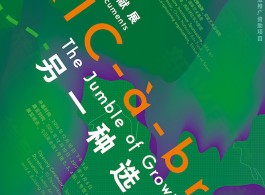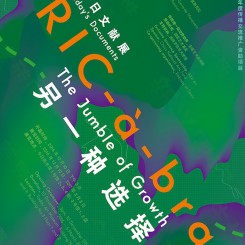On December 10th, 2016, the 3rd Today’s Documents opened at Today Art Museum. After the success of the previous two Documents, this new exhibition have been prepared for 6 years and finally met the public in Hall No.1 and No.3, TAM. The show will be open for 3 months, until March 5th, 2017.
Co-curators Huang Du and Gerardo Mosquera designed the show. It is titled in three languages: BRIC-à-brac (French), The Jumble of Growth (English) and 另一种选择(Chinese), and the idea behind these three names is that economic and social transformations are now happening all over the world. Across geographic boundaries, the 3rd Documents invites 50 artists from different countries and regions, including China, Mexico, Spain, Brazil, India, Russia, South Africa and Korea. Individual artistic expression aim to discuss what role art could play in the current chain reaction of emerging economies during the process of globalization and how art deals with these social transformations and their influence on social groups and individuals, and the conflicts among different geopolitics and cultures. The show observes the status quo in BRICs and other countries that face similar developing problems from different perspectives and stimulates the hybrid vigor of art in different cultural contexts and developing patterns in this globalized world.
Theme
This exhibition is titled in different languages, which is in line with the idea of “presenting multi-arts”. Its French and English names are “BRIC-à-brac: The Jumble of Growth”. The French expression is broadly employed to mean jumble, odds and ends, or an uneven group of things, with a certain undertone of confusion. The first word of this idiom coincides by chance with the acronym BRIC, which indicates the connection between the exhibition and geopolitics.
The term BRIC was first launched in 2001 by economist Jim O’Neill, referring to Brazil, Russia, India and China. And the term became BRICS to welcome a new member, South Africa, in 2010. The exhibition’s title refers thus to complexities and disparities that economic growth and accelerated modernization have unchained in the “living” societies of emerging countries. “BRIC-à-brac” stresses cultural collisions and the conflicts and collisions involved in social transformations under globalization.
The cultural integration based on global political economy leads to the co-existence of cultural interpenetration and cultural resistance: a mixed landscape in which the global and the local interact. This exhibition, taking BRICs as the starting point, discusses the substantial role that developing countries are playing in world’s economy for the first time, casting their influence not only locally, but internationally. During this process, art reflects the vigor of emerging economies in its unique way. How does art review and manifest the current social upheaval? And how could all these changes be presented in culture and in individual narrative? These may be key issues to be discussed in the show.
The Chinese title of this exhibition, “Another Choice”, is actually a further explanation of “BRIC-à-brac”, emphasizing the cultural subjectivity of emerging countries and their independent cultural development. It stresses the heterodox character of this mutation and, in a way, its “democratization” of world’s macro-economy, which now has spread all around the planet. BRICs, with their own unique geo-cultural characteristics, cradle the complicated and multiple development patterns of their local artists and inject new vigor into global cultural pluralism. It’s important to underline that this show examines the role that this very special culture plays in the development of emerging countries, via its representation and discussion in contemporary art, and reproduces another type of “alternative modernity”
.
Structure
The exhibition is divided in four parts: The Jumble of Growth, Chaotic Space, Discourse Practice and Individual Narrative, and Microscopic Bodies.
1.“ The Jumble of Growth” shows the revolution of regional artistic foundations and the symbiosis of different foundations. Art is influenced by regional culture, religion, and customs, but the new cultural foundation after these transformations brings about new content for art. Meanwhile, globalization enhances communication among countries as well as the interaction of cultures. Thus, new cross-cultural artistic elements and ideologies appear, which demand a global vision.
2. “Chaotic Space” reproduces the multi-dimensional spaces (urban space, public space, residence space, virtual space, etc.) in our complicated and diversified society, and presents their problems and positions. When these spaces encounter artists’ subjectivities, different opinions and imaginaries are stimulated, as well as different analysis and artistic expressions. Chaos in globalization and modernization actually provides a space for us to reflect on our living circumstances.
3. “Discourse Practice” shows how artists deal with real problems in life, creating artworks that experiment with, interpret and criticize these problems. Thus the “silent” artworks speak out their positions, opinions and attitudes. Such artistic practice is not only an active and personalized response to real life, but also a demonstration of cultural consciousness and subjectivity.
4. “Individual Narrative and Microscopic Bodies” aims to display the consciousness of life and status of individuals within the macroscopic social landscape. That is, using life instinct, existential affections and circumstances as the focus of individual narratives. Furthermore, the body, as the motif and carrier of artistic narration, is often regarded as a signifier. It usually engages with topics such as the complicated human conditions and their cultural boundaries. Bodies do not exist in isolation in the postmodern discourse. They are, instead, the bond of social relations, and they carry meanings at several levels: the body of nature, the body of society and the body of science. Artists look at the body as a medium for art, one that is beyond the limitations of the physical body. Based on such distinctive perspective, the artists use the body as a medium for art narration to explore and express the potential and the infinity in our bodies.
Highlights
This exhibition focuses on emerging economies. It uses the pun in its title to reflect about all these convoluted issues, trying to avoid simplifications. Art has the power to delve in depth into social and cultural matters by virtue of its tropological, subjective approach, which allows artworks to deal with the intricacies of society as well as its nature and complexities
Russian artists group AES+F shows The Feast of Trimalchio, originating form the most celebrated chapter of a satirical novel by ancient Roman poet Gaius Petronius (c. 27-66 AD) titled The Satyricon, to express their perception of the economic transformation in this globalized market. The artwork consists of three dramatic images, which were titled by the artists as “The Success of Asia”, “The Rise of Africa” and “The Decline of Europe”. The images show cultural pluralism and different cultural contexts in the process of modernization, and voice feelings of emerging economies and cultures that were once marginalized.
Simryn Gill’s installation Roadkill comments on urban problems caused by urbanization and industrialization by using real consumer’s waste collected by her on highways: plastic, bottles, cans, packages, cardboard, and many other vestiges that seem to spin along with the wheels in her piece, as well as in today’s expanding markets and consumer societies…
Mexican artist Marcela Armas’ work I-Machinarius represents an inverted map of Mexico, designed on the wall by a chain that moves noisily and irregularly through the action of several cogwheels operated by a hidden engine. The piece is a chaotic mechanism that leaks oil on the wall, which spills down to the floor, defiling the exhibition space, messing up the clean and light white wall.
Chinese artist Du Zhenjun’s photomontages for his Babel World series eloquently comment about the chaos of contemporary tremendous urban swelling and the jumble of its megalopolis. Cao Yu uses a new methodology to show her dialogue with Bruce Nauman. Be it in Cao Yu’s work “Self Portrait as Fountain” or in her performance spurting breast milk from her body, “Fountain”, she regards her body as a receptacle for life politics, possessing inexhaustible energy and potential for further expansion.
Significance
Since the first Today Documents in 2007, Today Art Museum has defined its culture identity: to gradually create a platform for international art dialogues based on the Chinese context, to parallel world well-known biennales and triennials, and further encourage communication among different cultures all over the world.
The 3rd Today’s Documents puts forward a sharp cultural proposition, gains new examination and observation of “contact zones” in contemporary art from the perspective of global localization, and stresses culture differences in the context of globalization. Via vivid and philosophic images, the show interprets the rise of fast emerging countries (represented by BRICs), and the deepening crisis in globalization and capitalism: a relationship of contradiction, conflict, interdependence and competition. Instead of avoiding social characteristics affected by region and politics, the show allows local artists to voice their own feelings, even including their self-awareness of resistance and struggle under the condition of culture absorption and fusion, which could reveal artists’mastery and understanding of “culture uniqueness”. The show encourages their self-recognition while discovering other cultures, so that a new cultural landscape could be created based on artistic dialogues and sharing. To summarize, the 3rd Today’s Documents is held to reflect on traditional issues while facing contemporary problems, and to explore cultural connotations while displaying the status quo of contemporary art.
-End-


